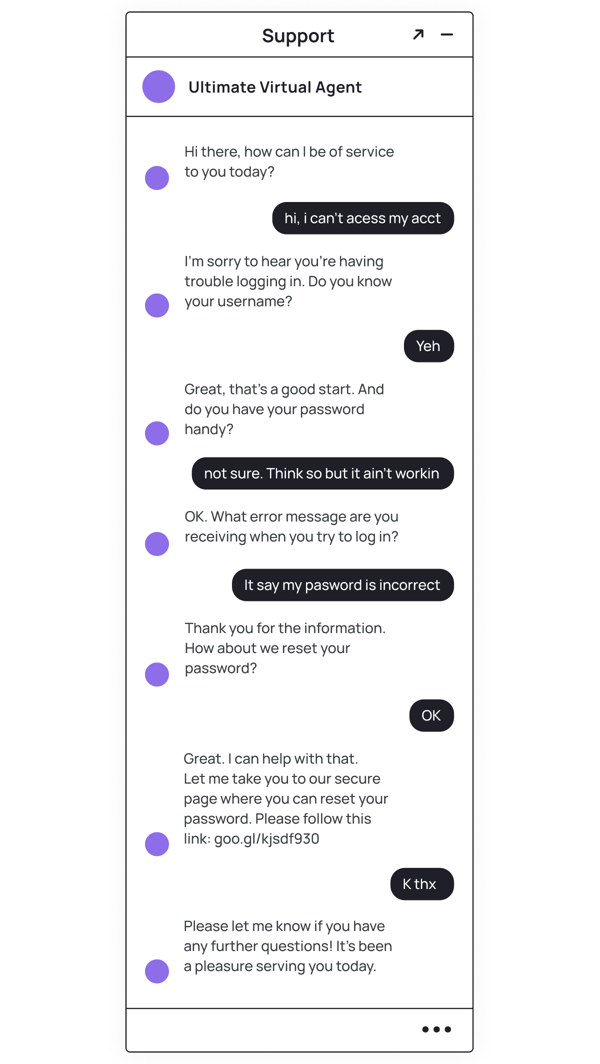Native speakers often bend the grammatical rules of their mother tongue. Their language (both spoken and written) is filled with colloquialisms, abbreviations, and typos or mispronunciations. NLU is an area of artificial intelligence that allows an AI model to recognize this natural human speech — to understand how people really communicate with one another.
Take a look at the example below:

This conversation between a person and an NLU-enhanced bot shows how much we expect from virtual agents. Not only must they be trained in all the grammatical rules of English, but they also need to detect human language as it is spoken or written: short form, mistakes, and all.
Are NLU and NLP the same thing?
While natural language processing (or NLP) and natural language understanding are related, they’re not the same. NLP is an umbrella term that covers every aspect of communication between humans and an AI model — from detecting the language a person is speaking, to generating appropriate responses.
NLU is a subdiscipline of NLP, and refers specifically to identifying the meaning of whatever speech or text is being processed. It can be used to categorize messages, gather information, and analyze high volumes of written content.
How does NLU work?
Natural language understanding works by deciphering the overall meaning (or intent) of a text. Rather than training an AI model to recognize keywords, NLU processes language in the same way that people understand speech — taking grammatical rules, sentence structure, vocabulary, and semantics into account.
This allows for much more accurate communication between bots and humans.
Find out more about conversational AI.
How NLU can upgrade your CX
Customers communicate with brands through website interactions, social media engagement, email correspondence, and many other channels. But it’s hard for companies to make sense of this valuable information when presented with a mountain of unstructured data.
That’s where natural language understanding comes in. There are 4 key areas where the power of NLU can help companies improve their customer experience.
1. Analyzing customer feedback
There are plenty of ways for customers to give their opinion on your brand: from interactions with customer support teams, to reviews, online surveys, and more. But human agents can struggle to gather and process information on customer satisfaction — especially when dealing with a large customer base and fragmented data sets.
NLU allows companies to quickly and easily analyze their customer feedback. Once you’ve identified trends — across all of the different channels — you can use these insights to make informed decisions on how to improve customer satisfaction.
What’s more, NLU is getting pretty good at learned associations. This is what our Chief Science Officer at Ultimate, Jaakko Pasanen is most excited about in terms of AI developments. He explains:
“You feed [the AI model] text like who is an uncle, child, sister, and then it learns to create associations in this family tree that it has never seen, and remember those associations. In a way this is the first step towards representing associations.”
- Jaakko Pasanen, Co-Founder and CSO, Ultimate
As AI continues to get better at predicting associations, so will its ability to identify trends in customer feedback with even more accuracy.
2. Tagging and responding to support tickets
Customer support agents can spend hours manually routing incoming support tickets to the right agent or team, and giving each ticket a topic tag. This drives up handling times and leaves human agents with less capacity to work on more complex cases. But with advances in NLU, virtual agents are able to do this job automatically.
Trained on your historical customer support data, a virtual agent learns how to identify, tag, and route tickets based on their category and priority. The more data the bot studies, the more accurate it will become. As well as ticket routing and prioritization, the VA can send automated responses to resolve simple queries.
With the help of Ultimate’s Ticket Automation solution, fintech company Pockit tackled their backlog of 17,000 emails and could serve their customers more quickly.
“In just two months, we were able to reduce about 95% of our support tickets backlog. We also reduced our response time from weeks to under two days, thanks to Ultimate’s Ticket Automation.”
- Jamie Hopper, Customer Service Manager, Pockit
Interested in Ticket Automation?
3. Monitoring employee satisfaction
Keeping your team satisfied at work isn’t purely altruistic — happy people are 13% more productive than their dissatisfied colleagues. Unhappy support agents will struggle to give your customers the best experience. Plus, a higher employee retention rate will save your company money on recruitment and training. That’s why it’s important to monitor employee satisfaction.
Traditional surveys force employees to fit their answer into a multiple-choice box, even when it doesn’t. Using the power of artificial intelligence and NLU technology, companies can create surveys full of open-ended questions. The AI model doesn’t just read each answer literally, but works to analyze the text as a whole.
This gives your employees the freedom to tell you what they’re happy with — and what they’re not. The NLU tech can analyze this data (no matter how many responses you get) and present it to you in a comprehensive way. With this information, companies can address common issues and identify problems like employee burnout before they become critical.
4. Identifying social media sentiment
Platforms like Twitter offer a treasure trove of customer feedback. But how could your team find the time to declutter this data? Enter NLU. With this technology, it’s possible to sort through your social media mentions and messages, and automatically identify whether the customer is happy, angry, or perhaps needs some help — in a number of different languages.
Analysis of social media sentiment can be incredibly useful for brands. Just look at Nike — when the company hired NFL quarterback Colin Kaepernick as a spokesperson, the media called it a marketing disaster. Good thing Nike didn’t listen: alongside some vocal criticism on social media, there was a wave of positive sentiment that saw the sporting manufacturer report a 31% increase in sales.
Where NLU still has room to improve
We can already do so much with NLU, but the technology isn’t perfect. NLU struggles with homographs — words that are spelled the same but have different meanings. While people can identify homographs from the context of a sentence, an AI model lacks this contextual understanding.
AI can also have trouble understanding text that contains multiple different sentiments. Normally NLU can tag a sentence as positive or negative, but some messages express more than one feeling. A human touch is needed in these complex cases.
Even with these limitations, NLU-enhanced artificial intelligence is already empowering customer support teams to level up their CX. As the technology matures, we’re excited to see what else it can do.
